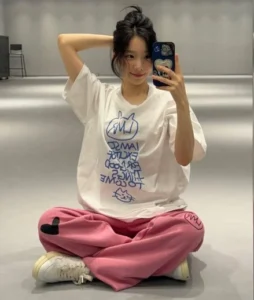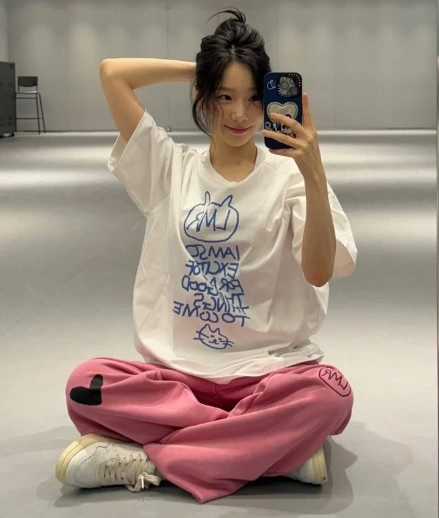Explore how Haeyo-che, the polite yet friendly Korean speech style, is used in Girls’ Generation’s K-pop hit “Kissing You.” Learn practical Korean politeness through lyrics!

1. Introduction: Why Haeyo-che Matters
For many learners of Korean, one of the first challenges is deciding which speech style to use.
Should you speak in a formal way, or in a more casual tone?
Among the various styles, 해요체 stands out as the most practical and widely used.
It is polite without being stiff, casual without sounding rude, and flexible enough to be heard in classrooms,
offices, TV dramas, and even song lyrics.
Unlike highly formal 합쇼체 or very casual 반말, 해요체 strikes a balance.
It is considered the “default” polite style in modern Korean, making it especially useful for learners
who want to communicate naturally in everyday life.
Understanding when and how to use 해요체 will not only help you avoid awkward social situations
but also make your Korean sound more authentic.
In this article, we will explore what 해요체 is, how it developed, why Koreans favor it in so many situations,
and how it compares to other speech levels. We will also look at practical examples from K-pop lyrics
and Korean dramas to see 해요체 in action.
2. What Is Haeyo-che?
해요체 is one of the main speech styles in Korean, often referred to as the polite or “default polite” style.
It is formed by adding -아요 / -어요 to verb stems, creating sentences that sound respectful yet approachable.
For example:
- 먹다 → 먹어요 – “I eat / You eat”
- 가다 → 가요 – “I go / You go”
- 공부하다 → 공부해요 – “I study / You study”
Compared to 합쇼체, which uses -습니다 / -ㅂ니다 endings and feels formal and distant,
해요체 is softer and easier to use in everyday conversations. Unlike 반말, which is casual and often used among close friends or younger people,
해요체 allows speakers to communicate politely without being overly stiff.
This versatility is why 해요체 is commonly used in classrooms, office meetings, TV shows, and even K-pop songs.
Learners who master 해요체 can participate comfortably in a wide range of social contexts,
making it an essential building block for practical Korean communication.
3. Why Koreans Prefer Haeyo-che
해요체 is often considered the most versatile speech style in Korean because it strikes a balance between politeness and friendliness.
It allows speakers to be respectful without sounding overly formal, which is especially useful in mixed-age groups, workplaces, and public settings.
Historically, Korean honorifics were heavily influenced by social hierarchy and age. Older generations often used 반말 or 합쇼체 depending on a person’s age or status.
Today, however, younger Koreans prioritize clarity and approachability in conversation, making 해요체 the default polite form in many situations.
Practical examples include classroom interactions, customer service, and casual media content.
For instance, a teacher addressing students might say,
“질문 있어요?” (“Do you have any questions?”),
which is polite and approachable. Similarly, in stores or cafés, staff often use 해요체 when speaking to customers,
maintaining professionalism while keeping the tone friendly.
In media such as TV dramas and K-pop lyrics, 해요체 is frequently used to convey natural, everyday speech.
Its versatility allows artists and writers to connect with audiences of all ages without sounding overly stiff or casual.
Mastering 해요체 helps learners navigate social interactions confidently, from informal daily conversations to semi-formal professional settings.
4. Understanding Haeyo-che Through K-pop: Girls’ Generation’s “Kissing You”
Haeyo-che is a versatile Korean speech style that sounds polite yet friendly. In Girls’ Generation’s “Kissing You”, casual speech and haeyo-che are alternated naturally.
Consider the following lines:
한글 가사:
너의 두 손을 잡고, 니 어깨에 기대어 말하고 싶어
고마워 사랑해 행복만 줄게요
English translation:
I hold your hands and lean on your shoulder, and I want to say
Thank you, I love you, I will only give you happiness
Here, the first line (“말하고 싶어”) can be understood as slightly narrative, even though it uses 반말 (informal speech). In the second line, the phrase “고마워 사랑해” remains in 반말, directly addressing the listener, but immediately shifts to haeyo-che in “행복만 줄게요.” This seamless transition without sounding awkward illustrates one of the key characteristics of haeyo-che: it allows speakers to be respectful and polite while maintaining a friendly, approachable tone.
If the lyric had used the more formal 합쇼체, for example, “고마워, 사랑해, 행복만을 주겠습니다,” it would feel very unnatural to Korean listeners. By contrast, “행복만 줄게요” in haeyo-che conveys respect lightly, while maintaining the intimate and gentle feeling established in the previous lines. This is a hallmark of haeyo-che: it allows a transition from informal speech to a polite form smoothly, keeping the tone soft and natural.
This characteristic explains why haeyo-che can be mixed with informal speech without causing awkwardness. It is polite enough to convey respect, yet casual enough to keep conversations warm and approachable.
Reference link: Girls’ Generation – Kissing You (Official MV)
5. The Flexibility of Haeyo-che: Adjusting Politeness Like Options
Haeyo-che is a versatile Korean speech style that can be adjusted in terms of politeness and casualness, much like adding or removing options when buying a car. It allows speakers to convey respect lightly while keeping conversation natural and approachable.
1. Examples with Common Verbs
| Verb | 반말 (informal) | 해요체 (lightly polite) | 합쇼체 / Full respectful form |
|---|---|---|---|
| 먹다 (to eat) | 먹어 | 먹어요 | 드세요 / 드십시오 |
| 가다 (to go) | 가 | 가요 | 가세요 |
| 오다 (to come) | 와 | 와요 | 오세요 |
2. Practical Situations for “먹어요”
- When an adult speaks to their child’s friend at home: instead of saying 먹어, they may say 먹어요 to add light politeness while keeping the tone approachable.
- When a senior (boss, teacher, or older peer) speaks to a junior or subordinate: using 먹어요 softens the speech without losing the hierarchical context.
3. Adjusting Politeness Smoothly
Haeyo-che allows speakers to modulate politeness like options in a product: not too casual, not too formal, and flexible across many social contexts. By choosing the appropriate ending, speakers can maintain warmth and friendliness while still showing respect. For instance, 먹어요 keeps the tone light and approachable compared to the stiff 드십시오, while still softening the informal 먹어.
6. Haeyo-che vs. Hasipsio-che (합쇼체)
In Korean, there are different levels of politeness, and choosing the right one is crucial for sounding natural.
Haeyo-che and Hasipsio-che (합쇼체) are two common polite speech styles, but they differ in formality and usage.
Hasipsio-che: Formal and Distant
Hasipsio-che uses endings like -습니다 or -ㅂ니다, giving sentences a very formal and official tone.
It is typically used in contexts such as news broadcasts, official documents, business presentations, or military communication.
For example:
- 먹다 → 먹습니다 – “I eat / You eat” (formal, respectful)
- 가다 → 갑니다 – “I go / You go”
- 오다 → 옵니다 – “I come / You come”
While Hasipsio-che conveys strong respect, it can sound stiff and distant in everyday conversation.
If a learner uses it in casual or semi-formal situations, it may feel unnatural to native speakers.
Haeyo-che: Polite but Approachable
In contrast, Haeyo-che uses endings like -아요 / -어요, providing politeness without creating too much distance.
It works well across a wide range of contexts, including:
-
- Classrooms: Teachers asking students, “질문 있어요?” (“Do you have any questions?”)
- Offices: Colleagues speaking politely but casually, “회의 준비됐어요?” (“Are you ready for the meeting?”)
- Media and K-pop: Characters or singers speaking naturally without sounding stiff
Haeyo-che allows speakers to maintain a friendly, respectful tone without the formality of Hasipsio-che.
It is especially helpful for learners who want to communicate politely in most social situations without worrying about sounding too rigid.
Practical Takeaways for Learners
- Use Hasipsio-che in highly formal or official contexts (news, official presentations, documents).
- Use Haeyo-che in classrooms, casual workplaces, cafes, and everyday interactions.
- When in doubt, Haeyo-che is generally safe and versatile: it conveys respect while keeping communication approachable.
By understanding the difference between Haeyo-che and Hasipsio-che, learners can adjust their speech according to the level of formality required, ensuring smooth and natural interactions in Korean society.
7. Haeyo-che vs. Banmal (반말)
Banmal (반말) is the informal speech style in Korean, often used among close friends, younger people, or in casual settings.
It can sound friendly and warm, but if used incorrectly, it may come across as rude or disrespectful.
Banmal: Casual and Intimate
Banmal uses simple verb endings like -어 or -아, creating a very direct tone.
For example:
- 먹다 → 먹어 – “Eat” (informal)
- 가다 → 가 – “Go”
- 오다 → 와 – “Come”
Banmal is appropriate when speaking to close friends, younger siblings, or children.
However, using it with someone older or in a professional context can sound disrespectful.
Haeyo-che: Safe and Polite Default
Haeyo-che provides a safer alternative, offering politeness without the stiffness of Hasipsio-che.
It can be used with people of any age or status, making it ideal for learners still unsure about social hierarchies.
- 먹다 → 먹어요 – “I eat / You eat” (polite, approachable)
- 가다 → 가요 – “I go / You go”
- 오다 → 와요 – “I come / You come”
In daily conversation, Haeyo-che allows speakers to express friendliness and respect simultaneously.
It is often preferred by younger Koreans even when speaking to peers or slightly older individuals, as it keeps interactions smooth and polite without overdoing formality.
Practical Tips for Learners
- Use Banmal only with close friends, younger family members, or children.
- Use Haeyo-che in nearly all other situations, especially when you are unsure of age or status.
- Haeyo-che helps learners avoid social faux pas while sounding natural and friendly.
By mastering the distinction between Haeyo-che and Banmal, learners can navigate Korean social interactions confidently, maintaining politeness and approachability in any setting.
8. Cross-Cultural Perspective: Comparing Haeyo-che
Understanding Haeyo-che is easier when we compare it to similar concepts in other languages.
Unlike English, which does not have formal versus informal verb endings, Korean provides distinct speech styles to indicate respect and politeness.
Haeyo-che vs. English Politeness
In English, politeness is conveyed mainly through word choice, tone, or modal verbs like could or would.
For example, “Eat” vs. “Please eat” shows a polite tone, but the verb itself does not change.
In Korean, Haeyo-che does more than add a polite word; it modifies the verb ending, allowing the speaker to be respectful without sounding stiff.
This makes Haeyo-che more flexible than English politeness forms because the same sentence can carry different levels of courtesy by adjusting the verb ending alone.
Haeyo-che vs. Japanese 丁寧語 (Teineigo)
Japanese 丁寧語 (teineigo) uses endings like です and ます to indicate politeness.
Similar to Haeyo-che, it is softer than the most formal forms (でございます) and safer than casual speech.
- 食べる → 食べます – “I eat / You eat” (polite, similar to Haeyo-che)
- 行く → 行きます – “I go / You go”
The key difference is that Haeyo-che can be used in more situations than Japanese teineigo, ranging from casual conversations to semi-formal settings.
It blends respect and friendliness, which is why it is often considered the most practical default speech style for Korean learners.
9. Conclusion: Why You Should Master Haeyo-che
Haeyo-che is the most practical and versatile polite speech style in Korean. By mastering it, learners can communicate naturally in a wide range of everyday situations—whether speaking with acquaintances, colleagues, or strangers.
It allows you to convey respect without sounding overly formal, maintaining a friendly and approachable tone. Unlike the stiff 합쇼체 or casual 반말, 해요체 provides a safe and flexible way to participate in Korean social interactions confidently.
From ordering at a café, interacting in classrooms, to understanding K-pop lyrics and Korean dramas, Haeyo-che is the default choice for learners who want to speak Korean naturally and politely.

